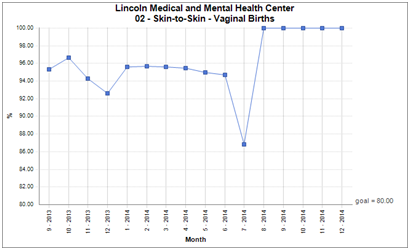eISSN: 2377-4304


Background: United Nations International Children's Emergency Fund (UNICEF), the World Health Organization (WHO) and many national government health agencies recommend that babies are breastfed exclusively for their first six months of life.1 Breastfed babies are less likely to suffer from serious illnesses, including gastroenteritis, asthma, eczema, respiratory infections, pneumonia, ear infections, otitis media, and sudden infant death syndrome.1-3
Objective: We hypothesized that by not separating infants and increasing Skin to skin (STS) contact our exclusive breastfeeding rates would increase. We conduct a quality improvement project, utilizing Multidisciplinary team with the aim of increasing breastfeeding rate and making our hospital baby-friendly.
Significance and conclusion: Multidisciplinary staff training, no separation of dyad unless medically indicated, STS contact, peer support, have been shown to be effective4 in promoting breastfeeding in new mothers. The Lincoln BFHI is an ongoing evolving project. We aim to improve our strengths, resolve the areas of weakness in the program and move forward for better results every day. As of February 27, 2015, Lincoln Medical and Mental Health Center, became the First Hospital in the Bronx, New York to attain Baby-Friendly designation and recognized by WHO, UNICEF and Baby-Friendly USA for promoting breastfeeding to improve infant and maternal health.5
Keywords: baby-friendly hospital initiative (BFHI), baby friendly 10 Steps, breastfeeding, kangaroo skin-to-skin contact, skin to skin (STS) contact, ten steps to successful breastfeeding
United Nations International Children's Emergency Fund (UNICEF), the World Health Organization (WHO) and many national government health agencies recommend that babies are breastfed exclusively for their first six months of life.1 Breastfed babies are less likely to suffer from serious illnesses, including gastroenteritis, asthma, eczema, respiratory infections, pneumonia, ear infections, otitis media, and sudden infant death syndrome.1-3,6 Adults who were breastfed as babies may be less likely to develop risk factors for heart disease such as diabetes, obesity and high blood pressure.1-3,6,7
There are benefits for mothers too: women who don't breastfeed have increased risk of developing heart disease, hypertension, diabetes, high cholesterol, breast cancer, ovarian cancer and hip fractures in later life.1
The Baby-Friendly Hospital Initiative (BFHI) is a global program to encourage and recognize hospitals and birthing centers that offer an optimal level of care for infant feeding and mother/baby bonding.8-10 The BFHI assists hospitals in giving all mothers the information, confidence, and skills necessary to successfully initiate and continue breastfeeding their babies or feeding formula safely.8
The BFHI aims to increase the numbers of babies who are exclusively breastfed worldwide, a goal which the WHO estimates could contribute to avoiding over a million child deaths each year, and potentially many premature maternal deaths as well.1
The Ten Steps3,7,10-13 for Successful Breastfeeding (Figure 1) for maternity settings are an evidence-based set of hospital practices, proven to increase breastfeeding rates in healthcare settings and beyond.14 Skin to skin (STS) has been identified as important for the initiation of breastfeeding. STS involves placing naked infant prone one mother’s bare chest, with infant back and head covered with warm blanket.15
Highlights of the importance are:
Improved:
Increased:
We hypothesized that by not separating infants and increasing STS contact our exclusive breastfeeding rates would increase from 16% in 2013 to 30% by 2014.
In 2012 Lincoln Medical and Mental Health Center applied and was accepted into the New York City Breastfeeding Hospital Collaborative (NYC BHC). This collaborative was initially comprised of 9 community and public hospitals and later grew to 18. Quarterly meetings involving upper management and leadership, monthly phone webinars and ad lib access to technical support to leadership that steered the cohort, gave Lincoln the tools and mechanisms by which to make systematic and sustainable changes to remove barriers to breastfeeding.
During the second half of 2014 intensive multidisciplinary training began in preparation for our pending assessment from Baby-Friendly USA INC. The following interventions were made to improve exclusive breastfeeding at Lincoln:
The (BFHI) aims at improving the care of pregnant women, mothers and newborns at health facilities that provide maternity services for protecting, promoting and supporting breastfeeding, in accordance with the International Code of Marketing of Breast milk Substitutes;1 the following results were noted on the breastfeeding initiative program at Lincoln:
Data was collected by a trained dedicated clerk who reviewed documentation in the EMR. Infant I&O, Medical staff, nursing, and breastfeeding team notes throughout hospital stay were reviewed. Findings showed that:

Figure 2 Rate of Skin to Skin Contact Immediately after Birth for NSVD within 5 minutes of birth for at least 1 hour or after completion of first feeding.
Multidisciplinary staff training, no separation of dyad unless medically indicated, STS contact, peer support, have been shown to be effective4 in promoting breastfeeding in new mothers. The Lincoln BFHI is an ongoing evolving project. We aim to improve our strengths, resolve the areas of weakness in the program and move forward for better results every day. While we have not achieved the goal of 30%, we have made sustainable changes and should gradually reach that outcome.
As of February 27, 2015, Lincoln Medical and Mental Health Center, became the First Hospital in the Bronx, New York to attain Baby-Friendly designation and recognized by WHO, UNICEF and Baby-Friendly USA for promoting breastfeeding to improve infant and maternal health.5

© . This is an open access article distributed under the terms of the, which permits unrestricted use, distribution, and build upon your work non-commercially.